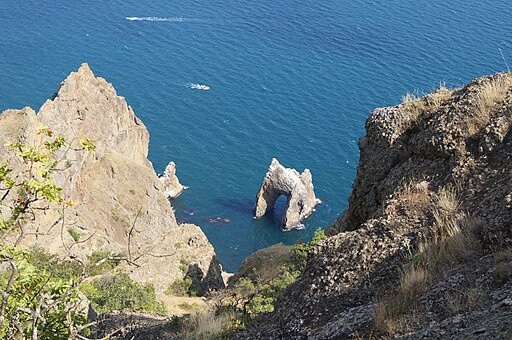Water plays an important role in the formation of different types of rocks. For this reason, it is no surprise to find rock formations along coastlines with strange appearance.

Qarlinngua Pants Arch
In the Brodeur Peninsula on Baffin Island in Canada, a rare rock formation is found about 56 miles (90 kilometers) from Arctic Bay, Nunavut. What makes this structure unique is that it resembles a pair of pants. The gigantic sea arch stands about 156 feet (50 meters) high. The Nunavut community calls it "Qarlinngua," which means "like pants" in the local language, Inuktitut.
In August 2023, a local hunter from Arctic Bay named Max Kalluk submitted a photo of this rock formation to CBC North. According to Kalluk, he first saw the formation when he was around 12 years old while passing by with his family while they were out hunting for narwhals.
Since the photo surfaced on social media, it has become a subject of much intrigue and disbelief. When CBC North shared its image on its Facebook page, many people dismissed it as a fake. This is because the slab of sedimentary rock seems impossibly thin for its great height. Aside from this, it is also more common to see natural formations farther south, in places such as Utah, Alberta, or the Oregon coast.
Even some geologists accustomed to studying rock formations were skeptical about their existence. Canada-Nunavut Geoscience Office chief geologist Linda Ham also said that their office in Iqaluit had never seen anything like it.
READ ALSO : Famed Darwin's Arch Rock Formation in Galapagos Islands Collapses Due to Natural Erosion
How Was the Pants-Like Structure Formed?
A formal investigation was conducted to determine if the pants arch exists. It has been confirmed by four geologists from across Canada who examined the photos.
However, only a few people have laid their eyes on it since it is very remote and inaccessible. This part of Canada is uninhabited and can only be reached during the summer months when the sea ice starts to melt away. Meanwhile, the arch can only be reached by boat, a four-to-five-hour ride from Arctic Bay.
According to Professor John England from the University of Alberta, most coastlines in the Arctic are still rising from the sea due to the unloading of the crust by the ice sheets that melted away about 10,000 years ago. This gradually moved the coastline away from the cliff. However, there are regions where the land is sinking relative to the sea.
Qarlinngua is scientifically labeled as a sea arch or natural arch, a structure formed by wind and water that erode the cliff rocks over time. This phenomenon results in isolated sea arches with unusual appearance. At the back of Qarlinngua is a rocky cliff with similar layering. Kalluk reported more unique formations in the area, like the one that looks like an elephant, just five minutes away by boat.
The pants-like arch is made of sandstone, a sedimentary rock, a good erodible material. The part of the arch that still stands likely contains a large volume of quartz, which can resist erosion. By examining the horizontal layers in the formation, experts assume that the structure is a Paleozoic rock about 250 to 600 million years old.
England estimated that the Qarlinngue could collapse and disappear after just a few decades, but other geologists believe it could take thousands of years. Since the cliff behind the formation will also erode, several new arches may also form.
Check out more news and information on Rock Formation in Science Times.
© 2025 ScienceTimes.com All rights reserved. Do not reproduce without permission. The window to the world of Science Times.











